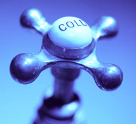Take steps now to protect your plumbing from freezing, as colder weather is ahead

Weather forecasters are predicting that the coldest weather of the season is still ahead of us, this February. To protect your property from frozen water pipes, understand the risk factors and know the preventative steps to take.
Related: Snow and ice can build up around outdoor water, gas and electrical equipment. Learn about the preventative steps you can take from our web page on Winter Safety.
Check plumbing
To check your plumbing, touch exposed cold water pipes. For example, in your basement or the incoming water pipes under the kitchen sink. If a spot feels unusually cold (or colder than in other spots) take measures to provide heat. Consider calling a plumber, as the problem can get worse.
Measures you can take include insulating pipes and external walls, or opening cupboard doors to improve warm air flow. If you have a frozen internal plumbing pipe, try using a hair dryer to thaw it. (Safety first: never leave a heating device unattended and be careful not to weaken plumbing joints.)
Preventative tips
Consider these tips to prevent problems with frozen internal plumbing and avoid costly issues with your privately-owned water service.
- Locate your master shut-off valve at the water meter. Ensure it is accessible and operating. This way you’ll know how to quickly turn off the water if
a pipe bursts . - Unscrew outdoor garden hoses, turn off the outdoor water supply, and allow the taps to drain, ideally before the first frost.
- Make sure that boxes and other items aren't blocking heat from getting to your water meter or exposed plumbing against exterior walls.
- Exposed plumbing pipes in exterior walls of your home, unheated basements and crawlspaces could be at risk. Insulate pipes or faucets in unheated areas, especially near outside walls and in crawl spaces, the attic and garage. This can be done with foam pipe covers available from building supply or home improvement stores. Avoid direct pipe contact with exterior walls.
- Seal cracks that let air in, which could potentially blow on exposed pipes. Check around windows and doors, electrical wiring, dryer vents and pipes. Ensure doors and windows are fully closed. Focus your attention on areas where your water lines run along outside walls or come up through floors, or in unheated basements and crawl spaces.
- Consider installing frost-free outdoor faucets.
- If you’re going to be away from your property for extended periods, turn off the master shut-off valve and drain the pipes, including external taps. Consider other systems in your building, including water heaters and water softeners, as they may be affected when your water is off.
- During periods of extreme and prolonged cold, leave a pencil-thin stream of water flowing from a cold water tap. Please note, you will be billed for the water used if you choose this step to protect your private property.
- Run cold water from the lowest point in the house, usually a laundry room sink.
- Ensure the drain is kept clear of debris to prevent overflowing or flooding.
While our customers' water conservation efforts are important and appreciated, this is a last-resort suggestion that can help a building owner avoid costly issues with their privately-owned water service. Consider placing a sign on the tap to remind occupants to leave the water running.
- When in doubt about internal plumbing issues, consult with a licensed plumber.
Frozen water services
Understanding the risks and preventative steps for frozen water service lines can help avoid future problems in case of extreme and long-duration cold spells.
During prolonged, extreme cold spells, any water service is at risk of freezing, and there are certain risk factors to be aware of. Knowing when the risks are high can help building owners take preventative steps to protect their property.
If you suspect that the water service line is frozen, don't delay; call Utilities Kingston right away at 613-546-1181. If the problem is inside the building, with internal plumbing, contact a licensed plumber immediately.
Watch this video to learn how Utilities Kingston responds when your water service line freezes. Carl explains the key components involved under ground, the plumbing set-up you will need inside your home, when to call a plumber and why. This will help reduce the impact if your service line freezes.
Be prepared
- The City of Kingston emergency management plan suggests that each household has at the ready four litres of fresh water, per person, per day for drinking and bathing.
- Know the number to call: report utility emergencies to us by calling our 24-hour line at 613-546-1181.
- Stay informed: you can keep up-to-date with service disruptions by following Utilities Kingston on Twitter and Facebook, or by checking http://www.utilitieskingston.com